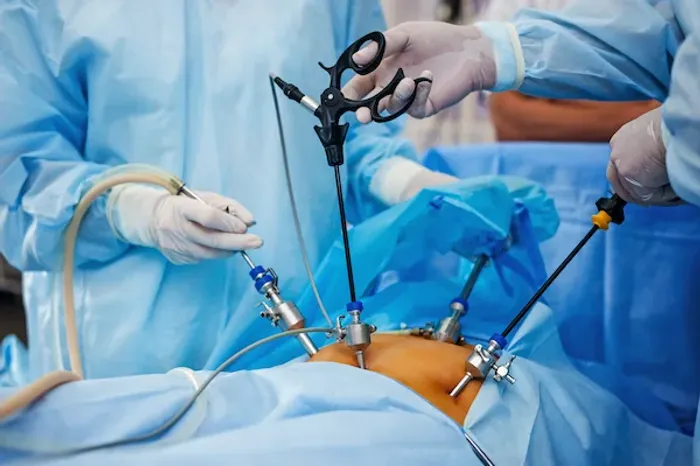The Evolution of Keyhole Surgery: From Keyhole to Pin-Hole Laparoscopic Procedures
Know about the keyhole surgery, technological advancements, role of laparoscopy and pin-hole laparoscopy, da vinci system, single incision laparoscopic surgery, future of it and more.


Introduction
Imagine undergoing major abdominal surgery and being discharged from the hospital within 24 hours, with barely visible scars and minimal pain. This was unimaginable a few decades ago, but today, it's the reality for millions, thanks to the remarkable evolution of keyhole laparoscopic surgery. This journey from large, invasive incisions to precision pin-hole laparoscopic techniques represents one of the most significant advancements in modern medicine. This article will guide you through this fascinating evolution, exploring how what began as a novel diagnostic tool transformed into the standard of care for countless procedures. We will trace the path from the first tentative laparoscopic explorations to the high-definition, robotic-assisted, and even single-incision surgeries of today, demystifying the technology that made it all possible.
The Era of Open Surgery: The Starting Point
Before the advent of laparoscopy, all abdominal surgeries were "open" procedures, known as laparotomies. This involved a single, large incision—often 6 to 12 inches long—to provide the surgeon with direct visual and manual access to the organs. While effective, this approach was akin to opening a large door to repair a small watch mechanism inside.
Consult a Top General practitioner for Personalised Advice
The Drawbacks of Traditional Laparotomy
The drawbacks of open surgery were significant and directly impacted patient recovery. The large incision caused substantial tissue damage, leading to severe postoperative pain that required strong pain medication. This, combined with the trauma of the procedure itself, resulted in long hospital stays, often extending to a week or more. The recovery period at home was equally prolonged, with restrictions on lifting and activity for several weeks. Furthermore, large incisions carried a higher risk of infection, bleeding and resulted in prominent, sometimes problematic, scars. The quest for a less traumatic alternative was the primary driver behind the development of minimally invasive surgical techniques.
The Birth of Laparoscopy: The First "Keyhole"
The conceptual roots of laparoscopy date back to the early 1900s, but it was used primarily for diagnostic purposes, like inspecting the abdomen. The true breakthrough came with the development of enabling technology.
The Pioneers and the First Laparoscopic Procedures
German surgeon Georg Kelling is credited with performing the first laparoscopic procedure on a dog in 1901. However, progress was slow until the invention of the rod-lens system by Professor Harold Hopkins in the 1950s. This was a pivotal moment. Previous endoscopes used a series of weak lenses with poor light transmission. The rod-lens system used glass rods with air spaces, dramatically improving image brightness and clarity. This innovation, commercialised by companies like Karl Storz, gave surgeons a viable "keyhole" to look through. The first laparoscopic appendectomy was performed by German gynaecologist Kurt Semm in 1980, a procedure initially met with scepticism from the surgical establishment.
Early Technology: The Role of the Rod-Lens System
The basic setup of early keyhole laparoscopic surgery involved making a small incision near the navel. A needle was inserted to inflate the abdomen with carbon dioxide gas (insufflation), creating a working space by pushing the abdominal wall away from the organs. Then, the laparoscope—a rigid tube housing the rod-lens system and a light source—was inserted. This allowed the surgeon to see inside the abdomen on a video monitor. Additional small incisions (ports) were made for long, slender instruments that the surgeon manipulated from outside the body. This was the fundamental shift: instead of looking directly at the organs, the surgeon operated by watching a screen.
The 1990s: Laparoscopy Goes Mainstream
Despite early innovations, laparoscopy remained a niche technique until a watershed moment in the late 1980s. The first laparoscopic removal of the gallbladder (cholecystectomy) was performed by French surgeon Philippe Mouret in 1987.
The Laparoscopic Cholecystectomy Breakthrough
This procedure became the catalyst for the widespread adoption of minimally invasive surgery. The benefits for patients were so undeniable—drastically reduced pain, shorter hospital stays, quicker return to work—that demand skyrocketed. Throughout the 1990s, surgeons rapidly adapted laparoscopic techniques for other procedures, including hernia repairs, anti-reflux surgery, and colorectal operations. This era marked the transition of laparoscopy from an experimental technique to the gold standard for many common abdominal surgeries, fundamentally changing surgical training and practice.
Technological Leaps: Enhancing the Surgeon's Vision and Skill
The mainstream adoption of laparoscopy fueled a cycle of innovation. As surgeons took on more complex cases, the limitations of the technology became apparent, driving improvements.
HDTV and High-Definition Cameras
The transition from standard definition to high definition (HD) and now 4K imaging has been revolutionary. Early video images were grainy and two-dimensional, requiring surgeons to develop a high level of hand-eye coordination. HD cameras provided a stunningly clear, magnified view of the surgical field, allowing for better identification of tissue planes, nerves, and blood vessels. This enhanced visualisation directly translates to increased precision and safety, reducing the risk of inadvertent injury and making complex dissections possible.
The Insufflator: Creating a Safe Working Space
While the camera is the "eyes" of laparoscopy, the insufflator is its "lungs." Early insufflation was rudimentary. Modern electronic insufflators are sophisticated devices that maintain a constant, preset pressure within the abdomen. This stable environment is crucial for patient safety and provides the surgeon with a consistent workspace, preventing the abdominal wall from collapsing and obscuring the view during long procedures.
The Rise of Pin-Hole Laparoscopy (Needlescopic Surgery)
The natural progression from standard laparoscopy was to make everything smaller. This led to the development of pin-hole laparoscopic surgery, also known as needlescopic or mini-laparoscopic surgery.
Defining Pin-Hole Surgery: What Makes it Different?
While standard laparoscopic instruments are 5-10 mm in diameter, pin-hole laparoscopic instruments are just 2-3 mm—about the width of a needle. These ultra-fine instruments allow surgeons to perform the same complex procedures through even smaller incisions. In many cases, only the camera port needs to be 10 mm, while the other working ports can be reduced to these pin-hole sizes.
Benefits of Reduced Port Site Trauma
The primary advantage is a further reduction in postoperative pain and scarring. Smaller incisions mean less tissue damage, leading to less pain and a lower requirement for painkillers. The cosmetic outcome is also superior, with incisions that often heal to become almost invisible. Some studies suggest a reduced risk of port-site hernias, a potential complication where the abdominal wall weakens at an incision point. If you are concerned about scarring or want the fastest possible recovery, discussing the feasibility of a pin-hole laparoscopic approach with your surgeon is a prudent step. A surgeon on Apollo24|7 can help you understand the best minimally invasive options for your specific condition.
Robotic Assistance: The Da Vinci System and Beyond
Robotic systems represent a paradigm shift, moving from the surgeon directly holding the instruments to controlling a robotic platform.
How Robotics Augments Laparoscopic Surgery
The da Vinci Surgical System, the most well-known platform, addresses several limitations of traditional laparoscopy. The system provides a 3D high-definition view of the surgical field. The robotic arms mimic the surgeon's hand movements but with a greater range of motion, filtering out hand tremors and allowing for micro-precise movements. This is particularly beneficial in confined spaces requiring delicate dissection, such as prostatectomy or complex hernia repair. While the cost of robotic laparoscopic surgery is higher, its benefits in precision for specific procedures are well-established.
Single-Incision Laparoscopic Surgery (SILS)
Pushing the boundaries of minimal scarring even further, SILS involves performing the entire operation through a single incision, typically hidden within the navel.
The Quest for "Scarless" Surgery
The appeal of SILS is primarily cosmetic, offering the potential for virtually scarless abdominal surgery. Special ports that allow multiple instruments to be inserted through one small incision have made this possible. However, the technique is technically challenging for the surgeon, as the instruments and camera operate in a parallel, "chopstick-like" fashion, losing the triangulation that makes standard laparoscopy easier. It is not suitable for all patients or all procedures, and its benefits over multi-port pin-hole laparoscopic surgery in terms of pain and recovery are still a topic of research.
The Future is Here: Advanced Imaging and Augmented Reality
The evolution continues with technologies that not only show anatomy but also reveal function.
4K/8K Imaging and Near-Infrared Fluorescence
Beyond 4K, emerging 8K cameras offer unparalleled clarity. Furthermore, near-infrared fluorescence imaging allows surgeons to see beyond the surface. By injecting a safe, fluorescent dye, surgeons can visualise blood flow to tissues (e.g., ensuring a bowel anastomosis has good blood supply) or identify critical structures like bile ducts during gallbladder surgery, preventing accidental injury.
Augmented Reality in the Operating Room
Augmented reality (AR) overlays digital information onto the real-world surgical view. For instance, a CT scan showing the location of a tumour can be projected directly onto the surgeon's view of the patient's anatomy. This "X-ray vision" helps in navigating complex anatomy and ensuring complete and precise removal of diseased tissue, personalising the surgery to the individual patient's anatomy.
Conclusion
The evolution of keyhole laparoscopic surgery is a testament to medical innovation to improve human lives. What began as a simple tube with a light has blossomed into a sophisticated array of technologies that make surgery safer, less painful, and more effective. The journey from keyhole to pin-hole laparoscopic techniques highlights a consistent trend toward minimising invasiveness while maximising surgical control and vision. If you are facing a procedure that may be suitable for a laparoscopic approach, having a detailed conversation with a qualified surgeon about the latest techniques, including pin-hole and robotic options, is essential. You can consult with a specialist surgeon online via Apollo24|7 to discuss the best modern surgical approach for your health needs.
Consult a Top General practitioner for Personalised Advice
Consult a Top General practitioner for Personalised Advice

Dr. Rajib Ghose
General Physician/ Internal Medicine Specialist
25 Years • MBBS
East Midnapore
VIVEKANANDA SEBA SADAN, East Midnapore

Dr Suseela
General Physician
5 Years • MBBS
Bengaluru
Apollo Medical Center, Marathahalli, Bengaluru

Dr. Suvadeep Sen
Critical Care Specialist
12 Years • MBBS, MD, FNB (CRITICAL CARE MEDICINE), EDIC
Mumbai
Apollo Hospitals CBD Belapur, Mumbai

Dr. Moumita Roy
General Physician/ Internal Medicine Specialist
8 Years • MBBS , MD (Anesthesiology)
Kolkata
VDC Clinic, Kolkata

Dr S Lakshmi Narasimha Reddy
General Practitioner
9 Years • MBBS
Kondapur
Singam's Kids Clinic, Kondapur
More articles from General Medical Consultation
Frequently Asked Questions
1. Is pin-hole laparoscopic surgery suitable for everyone?
Not always. Suitability depends on the specific procedure, the patient's anatomy, and whether they have had previous abdominal surgeries, which can cause scar tissue. Complex cases or patients with a high body mass index (BMI) might require standard laparoscopic or open techniques for safety. Your surgeon is the best person to determine the right approach for you.
2. What is the typical recovery time after a keyhole surgery?
Recovery is significantly faster than open surgery. For many common procedures like gallbladder removal, patients can go home the same day or within 24 hours. Most people can return to light activities within a week and resume normal activities, including exercise, within 2-4 weeks. Recovery time for keyhole surgery is one of its major benefits.
3. Are the results of laparoscopic surgery as good as open surgery?
For the procedures it's designed for, laparoscopic surgery is not only comparable but often superior. Studies show equivalent or better long-term outcomes, with the added benefits of reduced pain, shorter hospital stays, and better cosmetic results. It is considered the gold standard for many operations.
4. What are the risks of single incision laparoscopy (SILS)?
The risks of single incision laparoscopy are similar to standard laparoscopy, such as infection or bleeding, but it can have a slightly higher rate of incisional hernias at the single port site due to the larger incision needed to accommodate multiple instruments. It can also be technically more challenging, potentially leading to longer operating times in some cases.
5. How do I know if I'm a candidate for robotic surgery?
Your surgeon will determine if you are a candidate based on your medical history, the type of procedure, and the complexity of your case. Robotic surgery is often preferred for procedures in tight spaces requiring delicate reconstruction, such as prostate surgery or certain cardiac and gynaecological operations.




